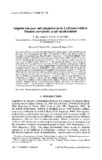Sulphide tolerance and adaptation in the California killifish, Fundulus parvipinnis, a salt marsh resident
Share
Abstract
Hydrogen sulphide is a toxicant naturally produced in hypoxic marine sediments, hydrocarbon and brine seeps and hydrothermal vents. The California killifish, a salt marsh resident, is remarkably tolerant of sulphide. The 50% lethal concentration is 700 μM total sulphide in 96 h, and 5 mM in 8 h (determined in flow-through, oxygenated sea water). Killifish exposed to sulphide produce thiosulphate which accumulates in the blood. The cytochrome c oxidase (a major site of toxicity) of the killifish is 50% inhibited by <1 μM sulphide. Killifish liver mitochondria are poisoned by 50–75 μM sulphide but can oxidize 10–20 μM sulphide to thiosulphate. Sulphide causes sulphhaemoglobin formation (and impairment of oxygen transport) at 1–5 mM in vitro and to a small extent at 2 mM in vivo. Killifish blood neither catalyses sulphide oxidation significantly nor binds sulphide at environmental (low) sulphide concentrations. Exposure to 200 μM and 700 μM sulphide over several days causes significant increases in lactate concentrations, indicating shift to anaerobic glycolysis. However, individuals with the most lactate die. In terms of diffusible H2S, the killifish can withstand concentrations two to three orders of magnitude greater than would poison cytochrome c oxidase. The high sulphide tolerance of the killifish, particularly of concentrations typical of salt marshes, can be explained chiefly by mitochondrial sulphide oxidation. Sulphide tolerance and mitochondrial sulphide oxidation in the killifish have a constitutive basis, i.e. do not diminish in fish held in the laboratory in sulphide-free water for 1–2 months, and are improved by prior acclimation.
Suggested Citation
Bagarinao, T., & Vetter, R. D. (1993). Sulphide tolerance and adaptation in the California killifish, Fundulus parvipinnis, a salt marsh resident. Journal of Fish Biology , 42(5), 729-748. https://doi.org/10.1111/j.1095-8649.1993.tb00381.x
Subject
Taxonomic term
Collections
- AQD Journal Articles [1249]

